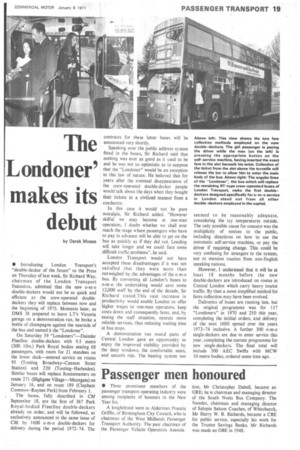The Londoner' makes its debut
Page 21

If you've noticed an error in this article please click here to report it so we can fix it.
by Derek Moses • Introducing London Transport's "double-decker of the future" to the Press on Thursday of last week, Sir Richard Way, chairman of the London Transport Executive, admitted that the new o-m-o double-deckers would not be as quick and efficient as the crew-operated doubledeckers they will replace between now and the beginning of 1975. Moments later, as DMS 38 prepared to leave LT's Victoria garage on a demonstration run, he broke a bottle of champagne against the nearside of the bus and named it the "Londoner".
On Saturday 39 "Londoners"—Daimler Fleetline double-deckers with 9.5 metre (30ft lOin.) Park Royal bodies seating 68 passengers, with room for 21 standees on the lower deck—entered service on routes 95 (Tooting Broadway–Cannon Street Station) and 220 (Tooting–Harlesden). Similar buses will replace Routemasters on route 271 (Highgate Village—Moorgate) on January 16, and on route 189 (Clapham Common–Raynes Park) from February 1.
The buses, fully described in CM September 18, are the first of 367 Park Royal-bodied Fleetline double-deckers already on order, and will be followed, as exclusively announced in the same issue of CM, by 1600 o-m-o double-deckers for delivery during the period 1972-74. The contracts for these latter buses will be announced very shortly.
Speaking over the public address system fitted in the buses, Sir Richard said that nothing was ever as good as it used to be and he was not so optimistic as to suppose that the "Londoner" would be an exception to this law of nature. He believed that for years after the eventual disappearance of the crew-operated double-decker people would talk about the days when they bought their tickets in a civilized manner from a conductor.
In this case it would not be pure nostalgia, Sir Richard added. "However skilful we may become at one-man operation, I doubt whether we shall ever reach the stage where passengers who have to pay in advance will be able to get on the bus as quickly as if they did not. Loading will take longer and we could face some difficult traffic problems", he said.
London Transport would not have accepted these disadvantages if it was not satisfied that they were more than outweighed by the advantages of the o-m-o bus. By converting all London's buses to o-m-o the undertaking would save some 12,000 staff by the end of the decade, Sir Richard stated.This vast increase in productivity would enable London to offer higher wages to one-man operators, keep costs down and consequently fares, and, by easing the staff situation, operate more reliable services, thus reducing waiting time at bus stops.
A demonstration run round parts of Central London gave an opportunity to enjoy the improved visibility provided by the deep windows, the comfortable seats, and smooth ride. The heating system too seemed to be reasonably adequate, considering the icy temperatures outside. The only possible cause for concern was the multiplicity of notices to the public, including directions on how to use the automatic self-service machine, or pay the driver if requiring change. This could be very confusing for strangers to the system, not to mention tourists from non-English speaking nations.
However, I understand that it will be at least 18 months before the new double-deckers are introduced on routes in Central London which carry heavy tourist traffic. By then a more simplified method for fares collection may have been evolved.
Deliveries of buses are running late, but the original programme was for 117 "Londoners" in 1970 and 250 this year, completing the infidel orders, and delivery of the next 1600 spread over the years 1972-74 inclusive. A further 300 o-m-o single-deckers are due to enter service this year, completing the current programme for new single-deckers. The final total will include 300 , AEC Swifts with MCW 10-metre bodies, ordered some time ago. ,












































































































































